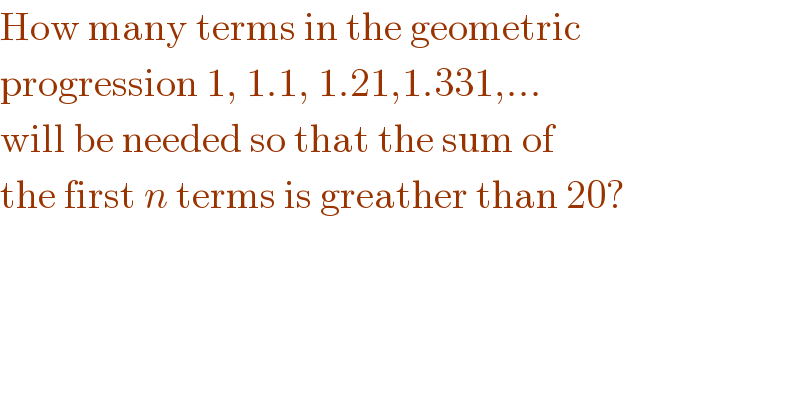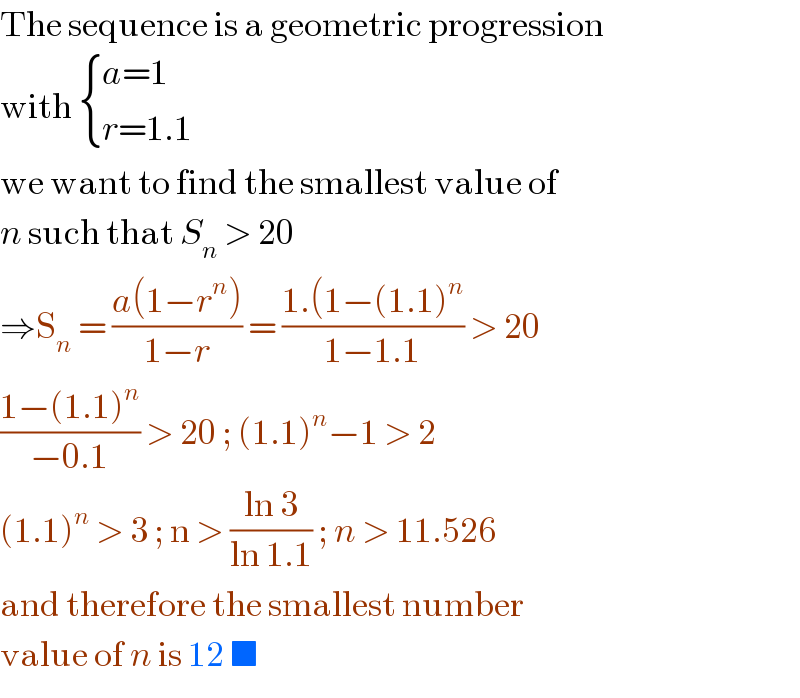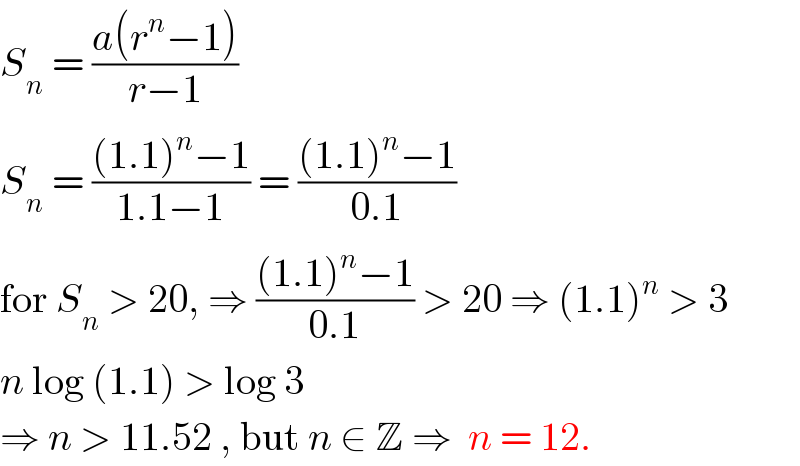
Question Number 99603 by bemath last updated on 22/Jun/20

$$\mathrm{How}\:\mathrm{many}\:\mathrm{terms}\:\mathrm{in}\:\mathrm{the}\:\mathrm{geometric} \\ $$$$\mathrm{progression}\:\mathrm{1},\:\mathrm{1}.\mathrm{1},\:\mathrm{1}.\mathrm{21},\mathrm{1}.\mathrm{331},... \\ $$$$\mathrm{will}\:\mathrm{be}\:\mathrm{needed}\:\mathrm{so}\:\mathrm{that}\:\mathrm{the}\:\mathrm{sum}\:\mathrm{of} \\ $$$$\mathrm{the}\:\mathrm{first}\:{n}\:\mathrm{terms}\:\mathrm{is}\:\mathrm{greather}\:\mathrm{than}\:\mathrm{20}? \\ $$
Commented by john santu last updated on 22/Jun/20

$$\mathrm{The}\:\mathrm{sequence}\:\mathrm{is}\:\mathrm{a}\:\mathrm{geometric}\:\mathrm{progression} \\ $$$$\mathrm{with}\:\begin{cases}{{a}=\mathrm{1}}\\{{r}=\mathrm{1}.\mathrm{1}}\end{cases} \\ $$$$\mathrm{we}\:\mathrm{want}\:\mathrm{to}\:\mathrm{find}\:\mathrm{the}\:\mathrm{smallest}\:\mathrm{value}\:\mathrm{of} \\ $$$${n}\:\mathrm{such}\:\mathrm{that}\:{S}_{{n}} \:>\:\mathrm{20} \\ $$$$\Rightarrow\mathrm{S}_{{n}} \:=\:\frac{{a}\left(\mathrm{1}−{r}^{{n}} \right)}{\mathrm{1}−{r}}\:=\:\frac{\mathrm{1}.\left(\mathrm{1}−\left(\mathrm{1}.\mathrm{1}\right)^{{n}} \right.}{\mathrm{1}−\mathrm{1}.\mathrm{1}}\:>\:\mathrm{20} \\ $$$$\frac{\mathrm{1}−\left(\mathrm{1}.\mathrm{1}\right)^{{n}} }{−\mathrm{0}.\mathrm{1}}\:>\:\mathrm{20}\:;\:\left(\mathrm{1}.\mathrm{1}\right)^{{n}} −\mathrm{1}\:>\:\mathrm{2} \\ $$$$\left(\mathrm{1}.\mathrm{1}\right)^{{n}} \:>\:\mathrm{3}\:;\:\mathrm{n}\:>\:\frac{\mathrm{ln}\:\mathrm{3}}{\mathrm{ln}\:\mathrm{1}.\mathrm{1}}\:;\:{n}\:>\:\mathrm{11}.\mathrm{526} \\ $$$$\mathrm{and}\:\mathrm{therefore}\:\mathrm{the}\:\mathrm{smallest}\:\mathrm{number}\: \\ $$$$\mathrm{value}\:\mathrm{of}\:{n}\:\mathrm{is}\:\mathrm{12}\:\blacksquare\: \\ $$
Commented by bemath last updated on 22/Jun/20

$$\mathrm{thank}\:\mathrm{you}\:\mathrm{both} \\ $$
Answered by Rio Michael last updated on 22/Jun/20

$${S}_{{n}} \:=\:\frac{{a}\left({r}^{{n}} −\mathrm{1}\right)}{{r}−\mathrm{1}} \\ $$$${S}_{{n}} \:=\:\frac{\left(\mathrm{1}.\mathrm{1}\right)^{{n}} −\mathrm{1}}{\mathrm{1}.\mathrm{1}−\mathrm{1}}\:=\:\frac{\left(\mathrm{1}.\mathrm{1}\right)^{{n}} −\mathrm{1}}{\mathrm{0}.\mathrm{1}} \\ $$$$\mathrm{for}\:{S}_{{n}} \:>\:\mathrm{20},\:\Rightarrow\:\frac{\left(\mathrm{1}.\mathrm{1}\right)^{{n}} −\mathrm{1}}{\mathrm{0}.\mathrm{1}}\:>\:\mathrm{20}\:\Rightarrow\:\left(\mathrm{1}.\mathrm{1}\right)^{{n}} \:>\:\mathrm{3} \\ $$$${n}\:\mathrm{log}\:\left(\mathrm{1}.\mathrm{1}\right)\:>\:\mathrm{log}\:\mathrm{3} \\ $$$$\Rightarrow\:{n}\:>\:\mathrm{11}.\mathrm{52}\:,\:\mathrm{but}\:{n}\:\in\:\mathbb{Z}\:\Rightarrow\:\:{n}\:=\:\mathrm{12}. \\ $$
